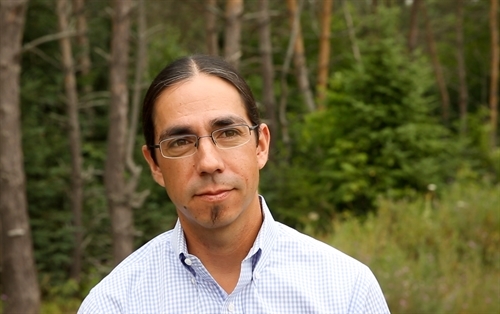Robert Hirschfeld, Water Policy Specialist for Prairie Rivers Network, explains what the Trump Administration's policies mean for our region's inland waters. MPC continues the conversation on Feb. 8 at our Roundtable event, One Year Later, Part One: Our Air, Land and Water.

Wes Jarrell, farmer and owner of Prairie Fruits Farm & Creamery, advocating for the Clean Water Rule in 2015.
 By Robert Hirschfeld, Water Policy Specialist, Prairie Rivers Network
By Robert Hirschfeld, Water Policy Specialist, Prairie Rivers Network - February 7, 2018
The early months of the new federal administration have been marked by a series of proposals that, in our opinion, would weaken many of the rules that keep our air and water clean.
To be clear, this was signaled throughout the campaign, and rearticulated in the recent State of the Union Address, with many commitments made to dismantle environmental regulations that we believe have largely served us well. President Trump’s administration, and particularly U.S. Environmental Protection (EPA) Agency Administrator Scott Pruitt, have been quietly effective at implementing an agenda of regulatory rollback that we believe threatens human health and the environment. The elimination of environmental protection provisions has recently been touted on posters hanging in EPA offices.
We at Prairie Rivers Network are acutely aware that this is a moment when our advocacy for healthy rivers and clean water is most critical. And here are just a few things we’ll be focused on in the coming months.
The Clean Water Act and Clean Water Rule
Within weeks of President Trump’s inauguration, he issued an executive order to begin repealing the Clean Water Rule, the rule that helps determine which bodies of water receive the protections of the Clean Water Act. The Clean Water Act, of course, is the landmark and foundational piece of environmental legislation, passed in 1972, that prevents pollution from being discharged into the nation’s waters. Though it may now be difficult for some to imagine, at one time, raw sewage and untreated industrial waste were dumped directly into our rivers and lakes. The Cuyahoga River in Ohio was so polluted that it famously “caught fire” in 1969, spurring a public outcry that would lead to the birth of the modern environmental movement.
Fire and fury, indeed.
The Clean Water Act changed the course of the nation’s history, establishing strong safeguards against the dumping of pollution into America’s waters. And though it does not prevent all types of water pollution (more on this below), it got us much closer to the goal of clean drinking water and swimmable, fishable lakes and rivers.
But there has been ongoing controversy as to exactly which waters the Clean Water Act covers. In 2015, EPA and the Army Corps of Engineers issued the Clean Water Rule to clear up the confusion. The 2015 Clean Water Rule would restore protections to the smaller and intermittent streams that help provide drinking water for 117 million Americans. This more expansive definition is consistent with the original intent of the Clean Water Act. It also makes logical and scientific sense, as water tends to move. It does little good to have rules that protect large bodies of water like the Illinois and Mississippi Rivers if you don’t protect the thousands of small streams that feed these bigger rivers.

"Nobody has a right to pollute. If something leaves my property line or goes downstream, that's my responsibility; I'm supposed to stop that. Clean water is absolutely central to the success of our business." —Wes Jarrell, Farmer, Owner, Prairie Fruits Farm & Creamery
Unfortunately, the bad news doesn’t end with the stripping of protections for smaller streams that provide drinking water to millions of Americans. We’re also in danger of losing some of the gains we’ve made since the big environmental bills of the 70s. Pruitt’s EPA is simply not enforcing federal pollution laws, and that means dirtier air and water, which will have an impact on human health.
The Farm Bill
The 2018 farm bill, expected in Congress later this year, comes at a moment of pending crisis for many farmers. Farmers are feeling the weight of several years of low commodity prices combined with burdensome debt. The answer to low prices has often been to squeeze more production out of each and every acre, which only serves to drive prices lower. Something has to give. Expect to hear a lot about crop subsidies and insurance, as well as calls to cut food stamps, which are also determined in the farm bill.
Too often overlooked, however, is that the Farm Bill offers the single largest source of funding for conservation on private lands. Farm Bill conservation programs encourage farmers to create wildlife habitat, conserve wetlands, improve soil health, sequester carbon, and address water quality concerns.

"Federal conservation programs have helped my family farm install proper fence and water systems for our cattle grazing operation. This allows our cattle access to clean water and quality forage. With proper rotations, our farm has been able to reduce erosion, stimulate soil health, and overall, increase our farm's productivity. By implementing conservation farming practices, a farmer can better work with nature and not against it." —Dallas Glazik, Farmer, Resource Conservationist, Cow Creek Organic Farm
While the Clean Water Act was successful in regulating pollution coming out the end of the pipe, we simply don’t have good rules to prevent agricultural runoff - including fertilizers, pesticides, and animal wastes - from entering our rivers and lakes. And this chemical runoff often then turns our water into toxic, algal soup, destroying critical wildlife habitat and fouling drinking water supplies. This is why farm conservation practices are so important. By keeping some land out of production, and preventing the destruction of pollution-filtering wetlands, we can help prevent runoff at its source, rather than relying on outrageously expensive water treatment systems.
Asian Carp and Aquatic Invasive Species
So this all sounds like bad news. But are there areas to work together? Can we bridge what feels like an obscenely large, and yet still growing, partisan divide?
The Asian carp issue has often seemed confirmation of the maxim that “all politics is local.” And, sure enough, over the last decade, we’ve seen Republicans and Democrats in the Great Lakes united in demanding action to prevent Asian carp from entering Lake Michigan through the Chicago Area Waterway System (CAWS) and devastating the commercial fishing and recreational industries, as well as the culture of the lakes.

"This has been our homeland since time immemorial. We've always been here, for ten thousand years or more. Commercial fishing, subsistence fishing, and the lake in general are a vital part of our community." —Doug Craven, Natural Resources Director, Little Traverse Bay Bands of Odawa Indians
But there is a converse, of course. Leaders in Illinois and Indiana have been generally unwilling to consider changes to the inland waterway system, for fear it might disrupt the shipping industry that utilizes it. That might be changing, however, as mayors around the region, including Chicago’s Rahm Emanuel, call for implementation of a compromise plan that would decrease the risk of Asian carp, while still allowing barges to move product on the water. That’s the good news.
What remains to be seen is whether the Army Corps, under the leadership of the new Assistant Secretary of the Army (ASA), will continue to recommend increasing our defenses against carp. The new ASA could scuttle plans that are currently in the works, which would throw the question back to a Congress that is struggling to keep the lights on, let alone create policy. The Corps will do what Congress tells it, so, ultimately, it’s on Capitol Hill to get this done.
A trickier question still is whether we will address the dozens of aquatic invasive species currently in the Great Lakes and poised to move into the Mississippi River basin. In the invasive species world, Asian carp get all the attention, but we know there are more species headed toward the Mississippi from the Great Lakes than vice versa. And some of these pose just as much threat to do economic and ecological harm as Asian carp.
We need to take the health of the Mississippi River just as seriously as we do the Great Lakes. There is, unfortunately, a long history of turning downstream communities into sacrifice zones because it’s easier (and cheaper) to send the problem “away” than to deal with it here and now. But that is neither just nor smart. There is no “away." We are all downstream from someone else. That is the refrain that runs through all three of these issues. And we should look out for our neighbor, just as we would have them look out for us.